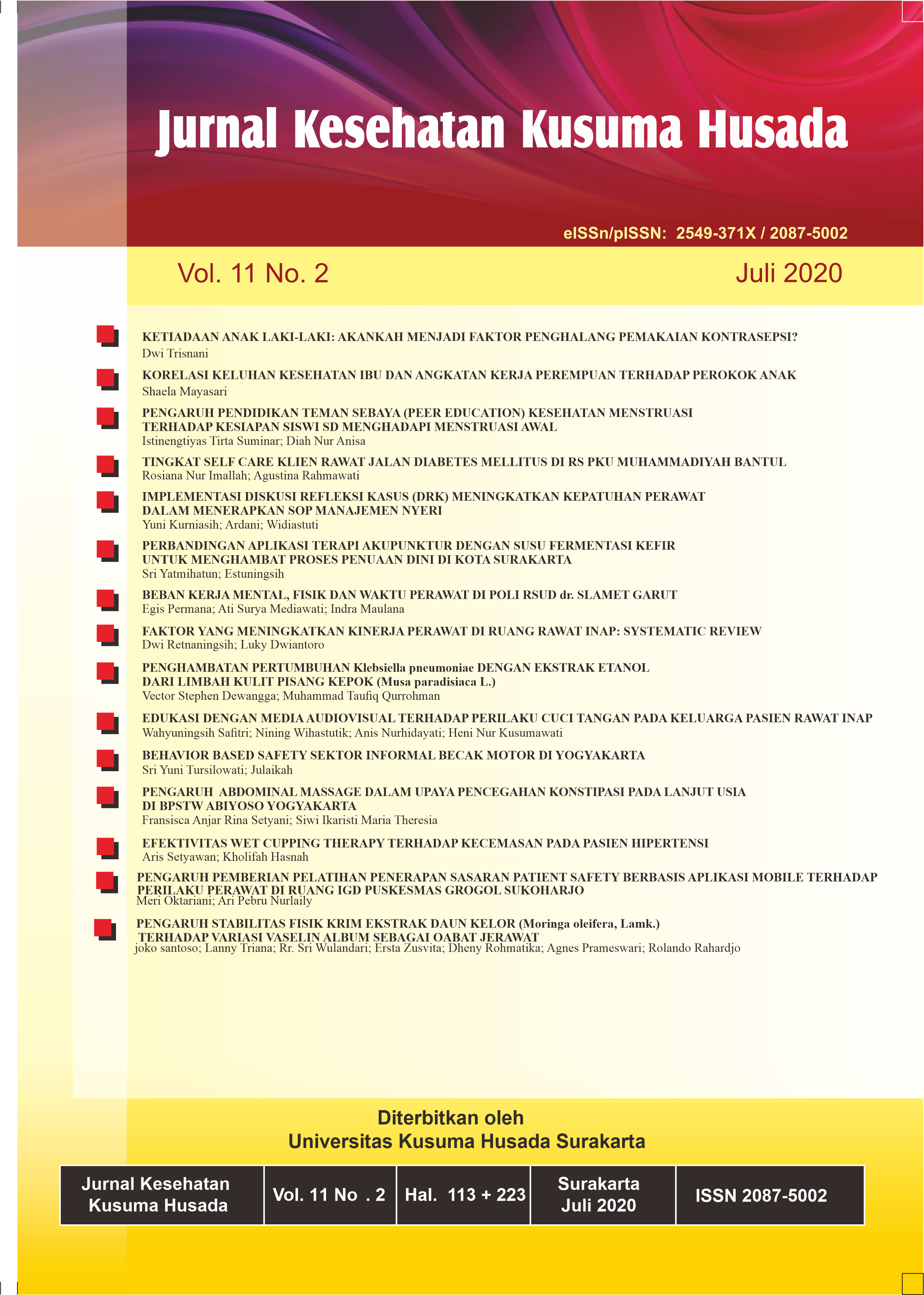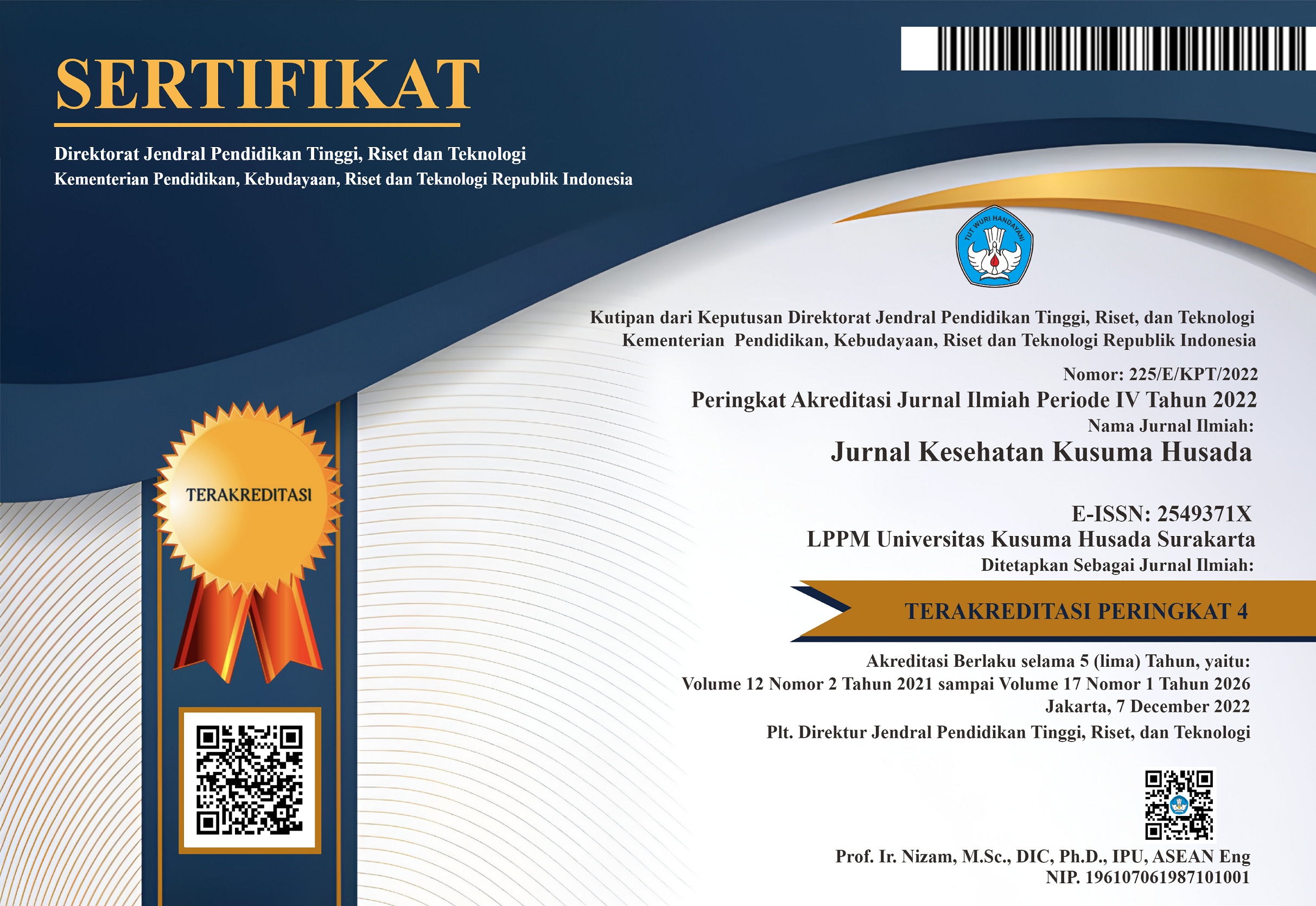PERBANDINGAN APLIKASI TERAPI AKUPUNKTUR DENGAN SUSU FERMENTASI KEFIR UNTUK MENGHAMBAT PROSES PENUAAN DINI DI KOTA SURAKARTA
DOI:
https://doi.org/10.34035/jk.v11i2.438Keywords:
kefir, penuaan dini, terapi, akupunktur, acupuncture, early aging, therapyAbstract
Penuaan atau aging merupakan perubahan manusia yang diakibatkan oleh faktor usia, psikologi, dan sosial. Penuaan juga dipengaruhi oleh faktor reactitive oxygen species (ROS) yang dihasilkan dalam sel. Tindakan akupunktur pada titik Zusanli (ST36) untuk anti aging mempunyai efek dalam melawan penuaan dengan meningkatnya aktivitas serum SOD dan penurunan serum Malondialdehyde (MDA). Kefir merupakan minuman susu fermentasi oleh mikroba atau bakteri asam laktat (Lactobacillus acidophilus, L. kefir, L. kerfigranum, L. parakefir) sehingga dikenal sebagai minuman probiotik karena mengandung mikroba yang baik untuk sistem pencernaan sehingga diketahui dapat berperan sebagai mencegah penuaan (aging). Tujuan penelitian untuk mengetahui perbedaan antara antara aplikasi terapi akupunktur dengan susu fermentasi kefir untuk menghambat proses penuaan dini di Kota Surakarta. Metode penelitian adalah Quasy eksperimental dengan pendekatan Randomized Controlled Trial. Hasil penelitian menunjukkan skor anti oksidan pada kelompok sebelum terapi akupunktur sebesar 22.823,53 dan kelompok pemberian susu fermentasi kefir sebesar 20.352,94, dan gabungan kelompok pemberian terapi akupunktur dan pemberian susu fermentasi kefir sebesar 23.411,76. Skor anti oksidan pada kelompok setelah terapi akupunktur 18.176,47 kelompok pemberian susu fermentasi kefir, 17.764,70, dan gabungan kelompok pemberian terapi akupunktur dan pemeberian susu fermentasi kefir 19.294,12. Kesimpulan tidak ada perbedaan antara ketiga perlakuan yaitu pemberian terapi akupuntur; susu fermentasi kefir maupun kombinasi pemberian terapi akupuntur dan susu fermentasi kefir untuk menghambat proses penuaan dini di Kota Surakarta namun perpaduan akupunktur dan pemberian kefir mempunyai hasil yang lebih bagus. Manfaat dari penelitian yaitu aplikasi akupunktur dan kefir minuman fermentasi dapat dijadikan referensi untuk inovasi sebagai terapi alternatif pada kasus penuaan dini.
Aging is a human change caused by age, psychology, and social factors. Aging is also influenced by the Reactitive Oxygen Species (ROS) factors produced in cells. The acupuncture action at the Zusanli point (36) for anti-aging results has an effect against aging with increasing serum SOD activity and decreasing serum Malondialdehyde (MDA). Kefir is a fermented milk drink by microbes or lactic acid bacteria (Lactobacillus acidophilus, L. kefir, L. kerfigranum, L. parakefir) so it is known as a probiotic drink because it contains microbes that are good for the digestive system so that it is known to play a role as preventing aging (aging). The purpose of this study was to determine the difference between the application of acupuncture therapy with kefir fermented milk to inhibit the process of premature aging in the city of Surakarta. The research method is an experimental Quasy with a Randomized Controlled Trial approach. The results showed the anti-oxidant score in the group before acupuncture therapy was 22,823.53 and the group giving kefir fermentation milk was 20,352.94, and the combined group giving acupuncture therapy and giving kefir fermentation milk was 23,411.76. Anti-oxidant score in the group after acupuncture therapy 18,176.47 group giving kefir fermentation milk, 17,764.70, and combined group giving acupuncture therapy and giving kefir fermentation milk 19,294.12. Conclusion there is no difference between the three treatments, namely the provision of acupuncture therapy; Kefir fermented milk and a combination of acupuncture therapy and kefir fermented milk to inhibit the process of premature aging in the city of Surakarta. The benefits of the research are the application of acupuncture and fermented beverage kefir can be used as a reference for innovation as an alternative therapy in cases of premature aging.
Downloads
Published
Issue
Section
License
The copyright of the published articles belongs to Jurnal Kesehatan Kusuma Husada.

This work is licensed under a Creative Commons Attribution 4.0 International License.
















